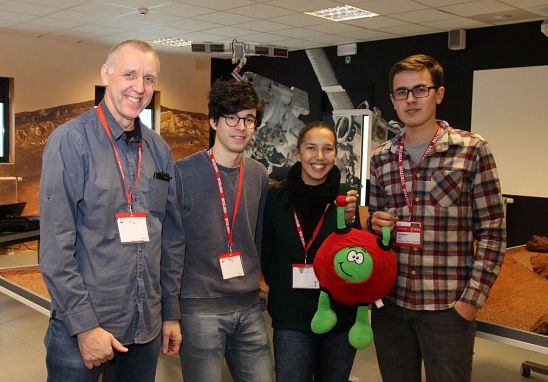Have you ever wondered why boiling water on the International Space Station is no simple task? It’s because of gravity. Or rather, it’s the lack of it.
Have you ever wondered why boiling water on the International Space Station is no simple task? Did you ever notice that the heads of the astronauts in space actually swell, and that they grow taller? Did you know that the flame of a candle in space doesn’t assume its familiar elongated shape, but becomes spherical instead?
It’s because of gravity. Or rather, it’s the lack of it. Microgravity is the reason for a plethora of incredibly fascinating phenomena which occur in space. And guess what? I have the opportunity to carry out research in a facility that can almost exactly recreate this environment.
My name is Tim and together with two friends from the University of Sevilla, Álvaro and Lidia, I was selected to participate in Drop Your Thesis! 2017. Drop Your Thesis! is a student programme of the European Space Agency’s Education Office.
Experiment
The coming year, we will prepare for an experiment in the ZARM Drop Tower in Bremen, Germany. This is a unique facility where you can launch a capsule in a 110 metre high vacuum chamber. Without air resistance, anything you drop in this tower will perform a nearly perfect free fall. During the 4.74 seconds of microgravity (or 9.3 seconds, depending on the mode) we will study the behaviour of ferrofluids. Ferrofluids are solutions of magnetic nanoparticles which can be moved around with small magnets rather easily. They have a manifold of interesting applications in space, and that is exactly why we want to study them.
 Tim and Lidia (both on the right side) at the ESA Training Week.
Tim and Lidia (both on the right side) at the ESA Training Week.Surprised
Well, we discovered quite quickly that it wasn’t working too well. After many tiring discussions, the two other international students dropped out. Álvaro and I found replacement in Lidia, another master’s student from Seville. We stepped up our teamwork and managed to hand in a decent proposal on time. To be honest, my expectation about our application wasn’t sky-high.
Nevertheless, three months later our acceptance letter arrived. I was incredibly surprised and excited about this opportunity. However, it also frightens me. This project will take a lot of time and effort, and as our contacts at ESA liked to say jokingly (or not?) during the kick-off week: “Regardless of your good efforts, things will go wrong. They always do!”.
Luckily, we have a lot of support from various experts in academia and industry. In the coming months I would like to share both the ups and downs in our project and our progress. And of course I will also show you some cool pictures of our hardware set-up! I hope you stay tuned, and don’t forget to follow our Facebook page.
Tim Hermans
Tim Hermans, a master’s student in space exploration, participates in the ‘Drop Your Thesis!’ programme at the European Space Agency. This is a hands-on student project in which an experiment will be designed and carried out in microgravity in the ZARM Drop Tower in Bremen, Germany. The exciting but challenging programme requires hard work and careful management and planning. The coming year, Tim will post monthly blogs every last Friday of the month about his experiences and the ups and downs of his project. You can follow Tim’s project team on Facebook as well.
Also read:
‘The art of outreach’
‘Designing the experiment set-up’
‘The drop experiment: how does it work?’



Comments are closed.